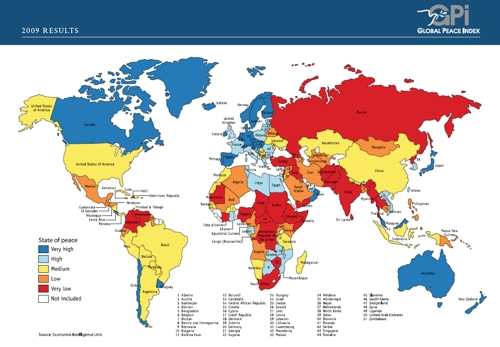 |
|
Vision Of Humanity | Global Peace Index |

- The Ranking
- Fact Sheet GPI 2009
- Results Report 2009
Methodology, Results, and Findings
The results of the Global Peace Index for 2009 suggest that the world has become slightly less peaceful in the past year, which appears to reflect the intensification of violent conflict in some countries and the effects of both the rapidly rising food and fuel prices early in 2008 and the dramatic global economic downturn in the final quarter of the year. Rapidly rising unemployment, pay freezes and falls in the value of house prices, savings and pensions is causing popular resentment in many countries, with political repercussions that have been registered by the GPI through various indicators measuring safety and security in society.
This is the third edition of the Global Peace Index (GPI). It has been expanded to rank 144 independent states and updated with the latest-available figures and information for 2007-08. The index is composed of 23 qualitative and quantitative indicators from respected sources, which combine internal and external factors ranging from a nation’s level of military expenditure to its relations with neighbouring countries and the level of respect for human rights. These indicators were selected by an international panel of experts including academics and leaders of peace institutions.
As before, the GPI has been tested against a range of potential “drivers” or potential determinants of peace - including levels of democracy and transparency, education and material wellbeing. The GPI brings a snapshot of relative peacefulness among nations while continuing to contribute to an understanding of what factors help create or sustain more peaceful societies.
The GPI was founded by Steve Killelea, an Australian international technology entrepreneur and philanthropist. It forms part of the Institute for Economics and Peace, a new global think tank dedicated to the research and education of the relationship between economic development, business and peace. The GPI is collated and calculated by the Economist Intelligence Unit, with whom this report is written in co-operation.
Defining peace
The concept of peace is notoriously difficult to define. The simplest way of approaching it is in terms of harmony achieved by the absence of war or conflict. Applied to nations, this would suggest that those not involved in violent conflicts with neighbouring states or suffering internal wars would have achieved a state of peace. This is what Johan Galtung defined as a “negative peace” - an absence of violence. The concept of negative peace is immediately intuitive and empirically measurable, and can be used as a starting point to elaborate its counterpart concept, “positive peace”: having established what constitutes an absence of violence, is it possible to identify which structures and institutions create and maintain peace? The Global Peace Index is a first step in this direction; a measurement of peace as the “absence of violence”, that seeks to determine what cultural attributes and institutions are associated with states of peace.
In 1999 the UN General Assembly launched a programme of action to build a “culture of peace” for the world’s children, which envisaged working towards a positive peace of justice, tolerance and plenty. The UN defined a culture of peace as involving values, attitudes and behaviours that:
- Reject violence
- Endeavour to prevent conflicts by addressing root causes
- Aim at solving problems through dialogue and negotiation
It proposed that such a culture of peace would be furthered by actions promoting education for peace and sustainable development, which it suggested was based on human rights, gender equality, democratic participation, tolerant solidarity, open communication and international security. However, these links between the concept of peace and the causes of them were presumed rather than systematically measured. For example, while Doyle and advocates of his liberal peace theory have held that democratic states rarely attack each other, the ongoing war in Iraq demonstrates how some democratic countries can be militant or belligerent - the justification for war often being that peace is ultimately secured through violence or the threat of violence.
Measuring states of peace
&nbThe difficulties in defining the concept of peace may partly explain why there have been so few attempts to measure states of peace across nations. This project has approached the task on two fronts - the first aim is to produce a scoring model and global peace index that ranks 144 nations by their relative states of peace using 23 indicators. The indicators have been selected as being the best available datasets that reflect the incidence or absence of peace, and contain both quantitative data and qualitative scores from a range of trusted sources. The second aim is to use the underlying data and results from the Global Peace Index to undertake investigations into the relative importance of a range of potential determinants or “drivers” that may influence the creation and nurturing of peaceful societies, both internally and externally.
